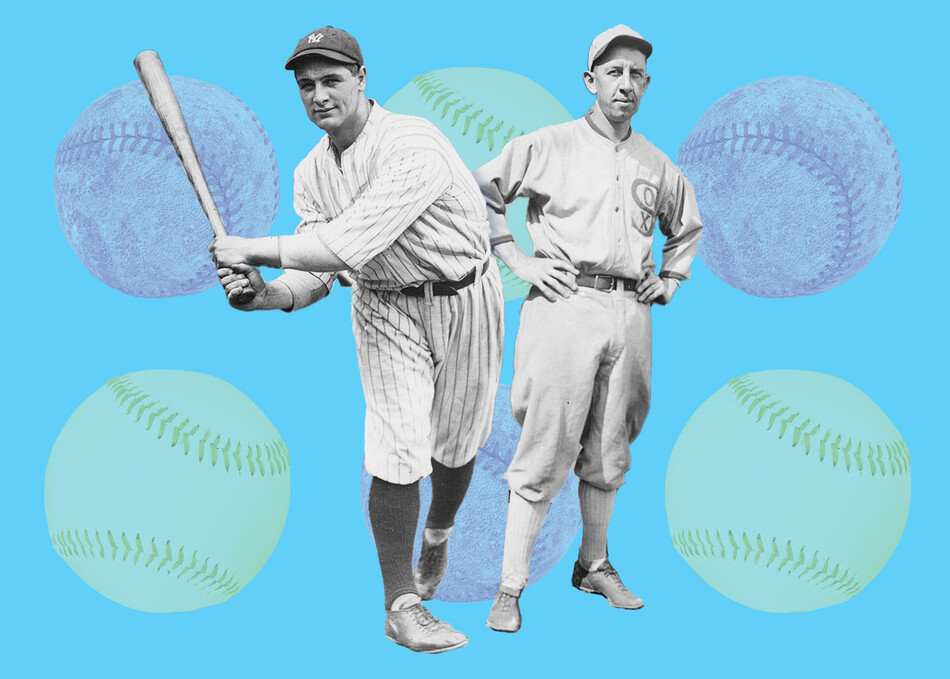He was arguably the best all-around major-league baseball player to ever come out of the Ivies, a model of durability who played for twenty-five seasons, longer than any position player in the twentieth century. He retired in 1930 with 3,315 hits; since then, only seven players have tallied more. He batted .340 or better ten times and stole 741 stolen bases. His 512 sacrifice bunts, and his defensive records for assists and total chances, are unsurpassed.
Yet when it comes to his place in Columbia's baseball pantheon, Edward Trowbridge “Eddie” Collins, Jr. 1907CC, of Tarrytown, New York — fittingly a second baseman — stands second behind another legend: Lou Gehrig of Washington Heights.
Gehrig was tall, strong, and handsome, and known around campus for the monster home runs he launched on South Field. He left college in 1923 to join Babe Ruth and the New York Yankees. The local press called young Gehrig “Columbia Lou,” and soon he and Ruth would become the most formidable tandem in baseball. A colossal run-producer, Gehrig won six championships with the Yankees. The rest has passed into folklore: the legendary consecutive-games streak, which earned him the moniker “Iron Horse;” the mysterious loss of power in 1939; the decision to bench himself that year, ending his streak at 2,130 games; the diagnosis of ALS; the “Luckiest Man” speech at Yankee Stadium; his death in 1941 at age thirty-seven.
Gehrig ascended to immortality, while Collins, whose supremely confident manner earned him the nickname in college of “Cocky” — and who also won six championships, with the Philadelphia Athletics and the Chicago White Sox — always trailed a few lengths behind. Their Hollywood portrayals echo this discrepancy: Gehrig, played by screen idol Gary Cooper in The Pride of the Yankees (1942), was the protagonist of a biopic, while the small, jug-eared Collins, played by comic actor Bill Irwin in Eight Men Out (1988), was a supporting character in the tawdry tale of the Black Sox Scandal, in which eight White Sox players (Collins not included) conspired with gamblers to throw the 1919 World Series.
But in June of 1925, thirty-eight-year-old Collins was the greatest Columbian on a major-league diamond. Fidgety, aggressive, and by many accounts the smartest player in the game, Collins had risen to stardom during baseball’s dead-ball era (1900–1920), when batters focused on scratching out hits and advancing runners. That age ended when Babe Ruth came along and made the long blast — the home run — the game’s biggest thrill and attraction. Collins was a batsman of the old school.
On June 3, Collins and the White Sox were visiting the Detroit Tigers at Detroit’s Navin Field. Collins was the manager of the White Sox as well as their second baseman, and he came into the game with 2,999 hits in his career — just one hit shy of three thousand, a rare and venerated milestone in baseball. Only five players in major-league history had reached that pinnacle: Honus Wagner, Cap Anson, Napoleon Lajoie, Tris Speaker, and the most prolific of them all, Ty Cobb of the Tigers, who was stationed in centerfield that day.
In the first inning, Collins stepped to the plate against Tigers pitcher Rip Collins (no relation) and smacked a ball up the middle. The ball landed in the outfield grass in front of Cobb for a base hit. That was number three thousand, and now Collins stood among giants.
Of course, no one could have imagined at the time that an even bigger story was in nascency in New York. A day earlier, on June 2, as the Yankees prepared to face the Washington Senators at Yankee Stadium, Yankee first baseman Wally Pipp complained of a headache. Manager Miller Huggins gave Pipp the day off and plucked twenty-one-year-old Gehrig from the bench to play first base. Pipp would never start a game for the Yankees again, and Gehrig would not sit out a game for another fourteen years.
It’s true that, in matters of enduring fame, Collins did not have the advantage of dying young, or of playing in New York. And while everyone had heard of the 1919 World Series scandal, few were aware that Collins was a rock of probity in the corrupted clubhouse. His scheming teammates, led by hatchet-faced first baseman Chick Gandil and pitcher Eddie Cicotte, tough guys who’d never much liked the college boy, knew better than to approach Cocky Collins with their dark bargain.
Not that Collins was above reproach. In 1906, as a Columbia junior, he had dipped into pro ball under the name Eddie Sullivan, playing six games with Philadelphia. He got caught, and was ineligible to play in his senior year (he coached the Lions instead).
Much later, after Collins retired as a player in 1930, Tom Yawkey, owner of the Boston Red Sox, hired him as general manager. In this role, Collins signed a young outfielder named Ted Williams, who would become, to many, the game’s all-time greatest hitter. On June 12, 1939, Collins was inducted into the Baseball Hall of Fame.
That same week, Gehrig received his diagnosis and retired. He lived out his last days confined to his home in Riverdale, under the care of his wife and mother-in-law. He died on June 2, 1941, exactly sixteen years after taking over first base for the Yankees. The next day, his body was laid out in the small chapel of the Church of the Divine Paternity on the Upper West Side, where thousands of fans came to bid him farewell.
Collins remained in the Red Sox front office. In 1945, under pressure from a Boston politician to open the Red Sox to Black players, Collins held a tryout for three Negro Leaguers, among them Jackie Robinson. Evidence (including Robinson’s own recollection) suggests that the audition was given grudgingly and disingenuously, and that neither Yawkey nor Collins had any intention of signing a Black player. When Collins died in 1951 at age sixty-three — four years after Robinson broke the color barrier with the Brooklyn Dodgers — the Red Sox were still eight years from integrating, and were the last team in the majors to do so.
In 2006, Columbia founded its Athletics Hall of Fame. Collins and Gehrig made first cut. Their plaques hang on a wall in the Dodge Fitness Center. Just upstairs, in a meeting room, a framed certificate stands on a shelf. It states: In memory of Henry Louis Gehrig and Edward Trowbridge Collins, two distinguished sons in the Baseball Hall of Fame. The room, however, is named after the first baseman, not the second baseman. It’s called the Lou Gehrig Lounge.



